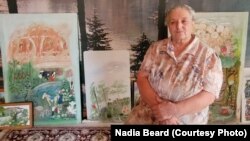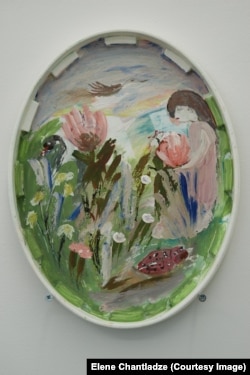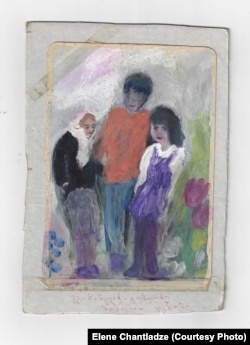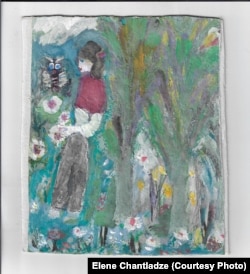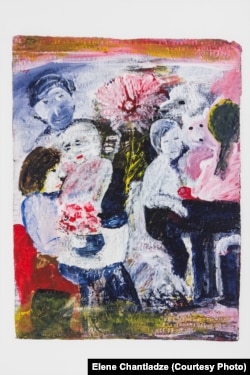TSKALTUBO, Georgia -- It was the year her husband died that Elene Chantladze stopped painting on stones and began painting on paper.
She had just turned 50 years old, and in her village in Tskaltubo in western Georgia, collecting stones -- an object associated with death in Georgia -- after her husband's passing would garner unwanted attention. "People would think I was crazy," she said. "So I started painting on anything I could find: scraps of paper, pieces of cardboard, the back of a wardrobe panel."
In the wood-paneled living room of her Tskaltubo cottage, the casual treatment of her many painted canvases, which rest against a wall along the floor, belie the value of her work. At the age of 76, Chantladze bears the unlikely profile of a recently discovered artist only just embarking on a career as an internationally celebrated painter.
In 2012, Tbilisi-based Georgian artist Nino Sekhniashvili came across Chantladze and her work at an open-air art fair in Tskaltubo. Since then, Chantladze's work has hung in galleries from Tbilisi to New York, with a selection of her paintings currently on display in the group show Girls Girls Girls at Lismore Castle Arts in Ireland.
Chantladze's work itself is striking in its style. Colors are often muted, but even when they're not, and a stroke of cherry red or mauve mark the canvas, it is always naturalistic. With a hazy, Impressionist-lite quality to the paintings, her subjects, invariably humans and the natural world, are captured effortlessly. Nature is unfussy but somehow elevated, and scenes feel pure and unpretentious.
"It's the honesty of her work that's so interesting," said Nika Lelashvili, gallerist and partner of LC Queisser, the Tbilisi gallery that represents Chantladze. "How raw it is, how emotional it is."
Born in 1946 in Supsa, a Georgian port village on the Black Sea, Chantladze's journey from nobleman's daughter to widowed painter is both a tale of unlikely coincidence as well as provincial quintessence.
Following a childhood spent frolicking with her brothers in the fields and rivers of western Georgia, Chantladze was forced to spend some of her later teenage years in hiding in Kutaisi. Bride kidnapping, which is now illegal, was rife in Georgian villages at that time and Chantladze was being actively pursued. When she arrived back home from studying in Tbilisi, however, her mother was informed she would be taken that night. Bride kidnappings in Georgia would see young women abducted from their homes by a suitor, who would then often coerce the woman into marrying him. Chantladze and her mother hitched a ride on a construction truck and left town immediately.
During her time in Kutaisi, men would come to the house offering to take her. "Nobody asked me what it was that I wanted," she remembers from an armchair in her living room. Her house, a one-story detached cottage with climbing grapevines in the garden, is typical of western Georgia. "I told my mother, 'Take me away from here, otherwise I'll have to marry just anyone.'"
One of her paintings, a small canvas crowded with characters, depicts the alleged founding story of the western Georgian mountain town Bakhmaro. Men dressed in an array of traditional mountain garb stand behind a fallen woman, the purple of her dress smeared with crimson. "A man from Guria fell in love with a woman and he took her to the mountains," Chantladze said, referencing a story she read in a book on Georgian ethnography. "The family of the woman followed. When they got to them, the man shot the woman so they wouldn't be able to take her away from him. That's how they named Bakhmaro. 'Bakh' is the sound Georgians use for a gunshot. 'Maro' was the woman's name."
Not all of Chantladze's paintings are so ethnographic, or local. Another painting, one portrayed on a large canvas, depicts Chantladze's ubiquitous pastoral trope augmented with tragedy. Children playing gayly among flowers is eclipsed by the scene above it: the image of children, lapped by orange paint and trapped in a building engulfed by flames. Underneath is painted the word "Beslan," the Russian North Caucasus town that was the site of a 2004 terrorist attack on a school that left over 300 people dead, more than half of them children, and hundreds injured.
"When I'm happy I don't paint," she said. "When I have insomnia or think about something focused, that's when I paint."
Like many of her generation, Chantladze agreed to marry her husband before having met him, the result of meeting and taking a liking to his mother. But it wasn't to be. "We married without love," Chantladze said. "He would ask: 'Do you love me?' and I answered, 'No, I hate you.'" Sometimes he threw her out of the house. Other times she would run away.
Among Chantladze's generation in Georgia, arranged and loveless marriages are a common story. Far less common, however, is a widowed village grandmother becoming an internationally celebrated artist in her 70s, says Lelashvili. "I cannot think of any other examples like Elene's," he said. Often responsible for looking after the family and domestic life, it is rare indeed that women of Chantladze's age are publicly prominent in a country where patriarchy is so firmly embedded across every part of society.
Although now known primarily for her paintings, Chantladze is also an avid writer of short stories and poems. To discuss her written work, many of which she calls "humors," is to invite laughter from both Chantladze as well as anyone in her company. But there is a poignancy to her writing, too, and an abstract invocation of the natural world that so populates her paintings.
In Tbilisi, the small but vibrant contemporary art scene is open and flexible, and therefore a good fit for someone like Chantladze, who defies many contemporary artistic trends both with her lightly candid works as well as her profile. Posta Press, a Georgian publisher, printed a book of Chantladze's paintings in 2019, with one side of the page a reprint of a painting, the other the backside of whatever material she painted it on: used calendars, scrap paper, and bits of cardboard.
Despite periods of unhappiness, Chantladze enjoys the company of her two daughters, grandchildren, and great-grandchildren, who she now supports with the proceeds of painting sales. "Strong emotions have punctuated every part of my life," she said. "At times I've hated myself, but being discovered as an artist and the kids around me are what give me a reason to take more pleasure in life."
There is a cyclical quality to Chantladze's relationship with nature. Many of the memories she recalls are of a carefree childhood with her siblings, whiling away the time in the woods and at the river.
"I love nature and sometimes kiss trees," she giggles. "I planted a small plum and it grew into a tree. I planted a twig and it grew into something. I plant things and they grow."
